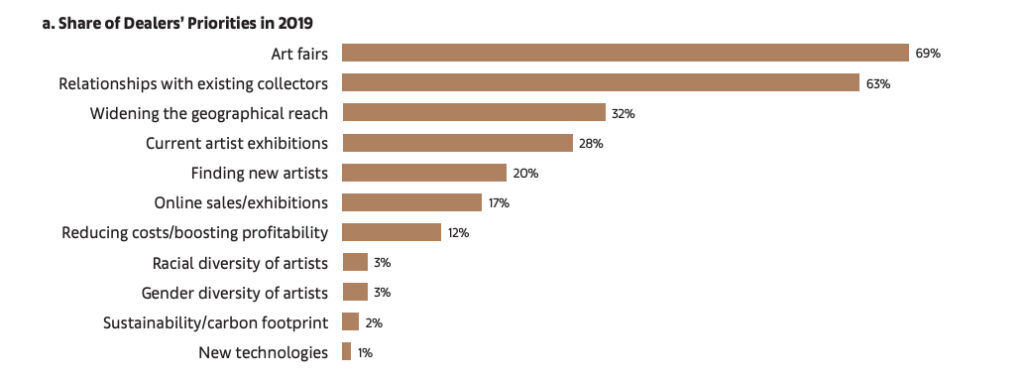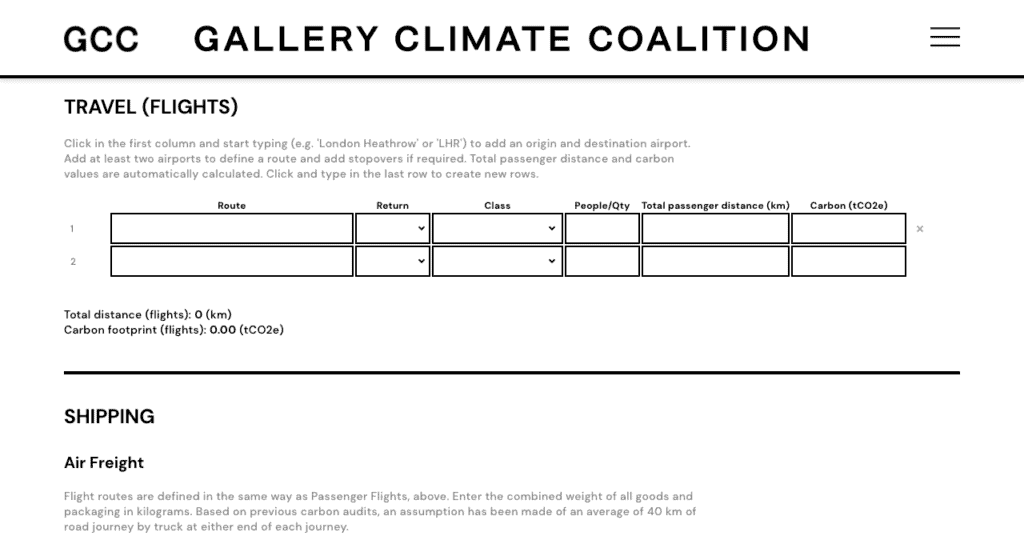Articles and Features
Sustainability in the Art World: Fighting the Environmental Crisis
By Adam Hencz
“This squandering attitude pushed the art world onto the verge of a carbon catastrophe.”
After over a year of game-over for large-scale international events, art fairs – from Enter Art Fair to Frieze – are well back, compelling the art world to face its impact on the environment once again.
Sustainability was never on top of the agenda in an industry where flying is essential and key transactions are initiated in the lavish milieux and the conspicuous, connected coolness of art fairs and international exhibitions. Indeed we saw modest attempts to help make a positive change, but advocating for a more climate-conscious art market by reducing waste by offering digital VIP cards and discontinuing print catalogs, while worthy, are clearly not enough to shrink the art world’s carbon footprint. However, the industry’s attitude has profoundly changed over the course of the past year and seems to have taken initiative to invest in positive responses to the growing climate crisis. The art world has taken up harmonized efforts to come to terms with sustainability and to bring awareness to the actions commercial galleries and cultural institutions can take in order to fight climate change.
What is sustainability?
According to the definition given by the United Nations World Commission on Environment and Development, sustainability refers to a kind of development that provides the best possible conditions for both people and the environment. Sustainable solutions use Earth’s resources in a way that doesn’t destroy the ability of future generations to meet their own needs. Unfortunately, the art world had had very little interest in replacing its destructive and unsustainable economic model until very recently, when the pandemic shook our lives and the whole world up. However, even though the contemporary art world has turned its attention towards the issue, promoting positive environmental causes, very small efforts have been taken by the industry itself to authentically engage with solutions that reduce its enormous carbon footprint. The art world is therefore urged to adopt sustainable measures by reconsidering conventional practices for shipping, traveling, and energy consumption.
A squanderer amid climate emergency
As Tom Seymour from The Art Newspaper points out, in 2019 – just one year before the pandemic – when the Art Basel and UBS Global Art Market Report asked art dealers all over the world to rank their top business priorities for the following five years, they equally marked attending art fairs, finding new clients and building better relationships with collectors of the utmost importance. Priorities regarding reducing the carbon footprint of their operation, sustainability art, and embracing new technologies were among the lowest-ranked concerns, with only 3% of art dealers wanting to deal with such issues as part of their five-year strategy. This attitude reflects an art market that depended on mechanisms that were far from sustainable as the jet-setting industry has been heavily event-driven over the last decades, with a densely packed calendar of live auctions, art fairs, and exhibitions that proved to be central to the exchange of information and sales. This is the attitude that pushed the art world onto the verge of a carbon catastrophe.

Facing the pandemic
In 2020, along with many other industries, the art world turned inward and launched desperate attempts to reinvent and capitalize on the online components of its market almost overnight. Despite the overall contraction of sales, aggregate online sales reached a record high of $12.4 billion, doubling in value from 2019. This period has also proven that art can be made, shared, experienced, and traded digitally. What is more, with no travel involved, along with the online distribution of the increasing number of digital artworks, the new market built up the potential to become a sustainable practice for the art world in the future. Concerns about the density of the frenetic calendar of events and the sustainability of travel began to be widely expressed as both galleries and collectors saw the halt as a chance to reflect on the role of large-scale events in their strategies and to consider more carefully the number of events they attend in the future.
Fighting the climate change
The pandemic clearly offered a glimpse of an alternative way for the market to function and joint efforts were made to embrace the digital realm and its ability to reduce carbon emissions. The Gallery Climate Coalition, an international charity providing environmental sustainability guidelines for the art sector founded by a group of gallerists and arts professionals, has grown from a dozen of members to an international network of more than half a thousand organisations, galleries, artists and individuals in the space of a year. The initiative sets out examples and recommends guidelines for a greener commercial art sector along with offering a digital carbon calculator for artists and galleries that allows them to make a good estimate of their carbon footprint.
The GCC defined a handful of key areas of action as a starting point to help galleries define potential steps to take to reduce their emissions. Transportation of artworks, business travel, and the energy used in the galleries themselves are among the main activities that are the biggest contributors to greenhouse gas emissions in the art sector. “The biggest change we can make to reduce our carbon footprint will probably relate to flights and shipping,” discusses Artlogic founder and CEO Peter Chater in an essay. “In comparison to these areas, a typical art gallery’s digital carbon footprint will be tiny.”

Choosing sea freight over air freight, participating in more local fairs, or using recycled and bio-based products for wrapping artworks could all mean a significant step towards reducing carbon emissions. Making online activities more sustainable by using environmentally-friendly IT companies and switching email and business applications to cloud computing services also lowers energy consumption. Galleries also have the means to opt for sophisticated digital experiences like Artland VRooms, which gives them limitless possibilities to compose and install compelling virtual exhibitions, whilst simultaneously making conscious choices to expand their program.
Future perspectives
Earlier this year, Christie’s became a patron of GCC and pledged to be carbon net-zero by 2030. Committed to becoming an art industry leader in environmental practices, Hauser & Wirth appointed Global Head of Environmental Sustainability not so long ago. Whether these efforts really are genuine acts, or they are marketing stunts, it is beyond doubt that today galleries must address environmental challenges and will hardly be able to survive if they stick to a business plan that belongs to the state-of-affairs of an ignorant era. Even though their long-term effects are yet to be seen, the art world’s recent efforts for sustainability give grounds for cautious optimism. It is finally becoming a widespread practice for dealers to thoroughly audit their carbon footprint as well as to execute an inhouse climate action plan that reflects the concerns of the world outside.
Relevant sources to learn more:
About sustainability in architecture:
Sustainable Architecture: Between Ancient Materials and New Practices
Innovative Architecture: Ten Buildings that Redefine Sustainability
A selection of environmental art and sustainability art related articles:
Environmental Art: Changing Our Habits Or Just Illustrating What We Already Know?
Living a Harmonious Contradiction. A Journey into Bio and Eco-Art
Top 10 Land Art and Earthwork Pioneers
How the Crypto Art Boom is Changing the Art Market
Wondering where to start?



